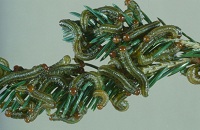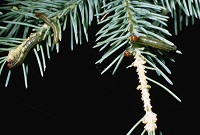Pikonema alaskensis (Rohwer)
Hosts

Photo credit: Therese Arcand, Natural Resources Canada.

Photo credit: Jess Hahn, University of Minnesota, Natural Resources, bugwood.org
Colorado and white spruce
Appearance and Life Cycle
Adult yellow-headed spruce sawflies emerge in the spring just as the buds on spruce trees are beginning to swell. Females deposit eggs singly into the base of new needles. Larvae emerge within two weeks and begin feeding on the succulent needles. By early to mid-July the larvae are full grown and are about 20 millimetres (mm) in length. Full grown larvae have brownish-orange heads and green bodies marked with six greyish-green stripes. Fully developed larvae drop to the ground and overwinter in cocoons in the soil. The sawfly completes one generation per year.
Damage
Larvae of the yellow-headed spruce sawfly initially feed on the new needles, leaving only short brown stubs. Once the new growth is devoured, the larvae move back on the branch and feed on the older needles. By July, infested trees appear ragged and yellowish-brown especially near the tops. Heavily-infested trees may be completely stripped of foliage. Three to four consecutive years of moderate to heavy attacks can kill the tree. The yellow-headed spruce sawfly prefers young, open grown trees, resulting in extensive damage to spruce used in plantations and shelterbelts on the Prairies.
Control
Infestations on a few small trees can be controlled by picking off and destroying the larvae when they are first noticed. For shelterbelts or large trees, chemical control can be achieved with one of the following insecticides: acephate, carbaryl, diazinon, dimethoate, malathion or permethrin. Insecticide application should be made when damage is first noted.